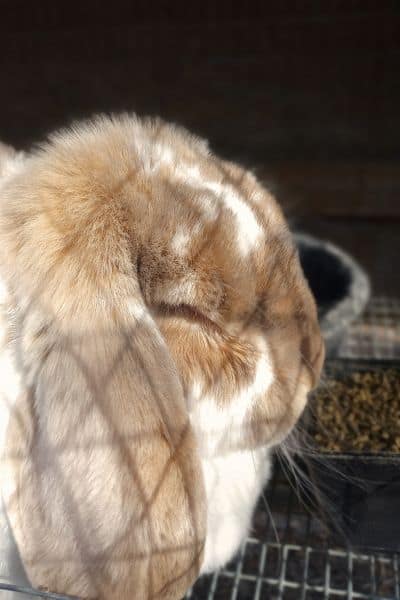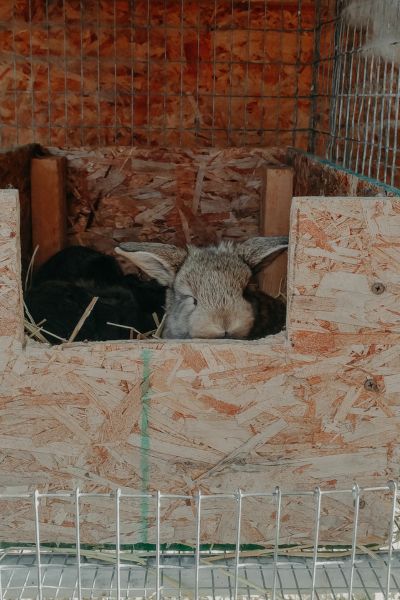What Do Baby Rabbits Eat From 0-8 Weeks Old And How To Introduce New Food
There could be several reasons why you are searching for “what do baby rabbits eat?” But first, let me be clear that I am going to talk about domestic rabbits, not wild baby cottontails.
Raising rabbits is one of the hardest things you will do on your backyard farm. Sometimes the mother rabbit will not get enough milk, sometimes she won’t even know what to do when she has a litter and you might have to hand feed the young rabbits.
You have to become a detective and figure out what the issue is and simply keep trying. Let’s get into at what stages rabbits cage food then I will get into some of the issues you might run into.
Rabbits under 2.5 weeks are fully on their mother’s milk.
Once they hit this point they might be interested in testing out solid foods at this point.
So around the time the babies’ eyes are fully open and they have been walking around the nest box for a few days I will set a small container of pellets in the nest box for them to try if they want. If you use really high-walled next boxes like me (mine are about 12 inches high) you might have the doe start weaning the kits but they may not be able to get out of the box yet and go find food. So you don’t want to wait until three weeks or they could start to lose weight.
Baby rabbits at 3 weeks of age should mostly be eating pellets and just occasionally seeking nursing. (below is a three-week old french lop)

By 4-5 weeks old your kits would not be nursing or should I say your doe should not likely be allowing it. If you see a doe letting her litter nurse at this age she is likely a pushover and has not pushed them away enough. But in most cases, baby rabbits are eating solely solid food by 4-5 weeks and do not need their mom. Make sure to have unlimited pellets available to the litter at this age.

Note: Some young bunnies will sit in the feed bowl and take a dump at that same time. Causing the other rabbits to either eat soiled food and or a lot of feed waste at the same time. You might have to feed them twice a day or just enough so they can clean up in a few hours and then feed again later until the kits get a little bit older and they stop the habit if sitting in the bowl.
This is why I like to have cage cups that lock down on the side of the cage so you can have them higher up on the cage so they are not as tempted to sit in it. Most of the time it takes the kits getting too big to sit in the bowl before they will stop doing it.
When Do Your Baby Rabbits Need Water
Your young rabbits should have constant access to fresh water around the same time they start showing interest in the feed. They aren’t drinking water while they are nursing because they are getting what they need from their mother.
But once the female rabbit starts reducing the amount they are nursing the kits need to be able to get access to water. Some water their rabbits using a water bottle and that is fine but it can be complicated for young rabbits.
So I would recommend a shallow bowl for them to drink out of BUT it needs to have hight enough edges that the kits can’t easily get into even if they won’t be drowned. This bowl below is pretty deep but once the kits are old enough to be drinking out of it I make sure that it says full enough that they can drink out of it and not have to lean too far into the bowl and fall in.

How Often Do Baby Rabbits Eat
Your newborn babies will nurse once or twice a day. You may never see the doe feed them and that’s ok. That’s why it’s important you know what you are looking at when the kits are young. It takes time to learn but you will get there.
If your kits are looking full and do not have wrinkles on their back then they’re doing great. If they are looking like the kit below then they are definitely not doing well.
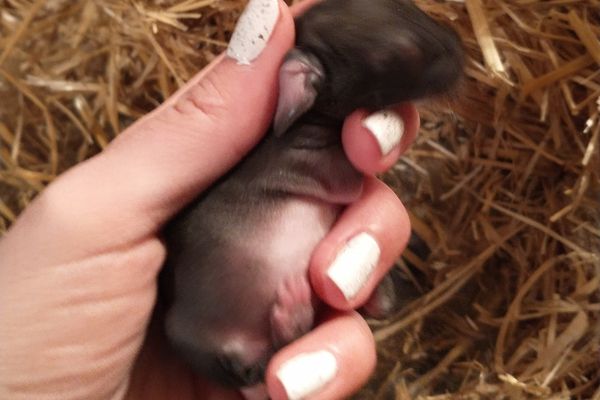
Every once in a while I have a doe that just does not care and will jump in the nest box with me there but that is not common.
Most of the time, if I go out to the caging area while she is feeding, the mother will jump out of the nesting box. (If I see her before she jumps out I will come back in a few minutes after she is done feeding.)
Her natural instinct is to run away from her nest to get any kind of danger to follow her and not cause harm to her babies. That is amazing, isn’t it! So I don’t want to disturb her while she is in the middle of feeding her babies.

DO NOT Feed Your Young Rabbits Anything But Pellets
I take a different stance on this than some people. Rabbits have VERY a sensitive digestive system and you HAVE TO be careful what you introduce to them, especially at a young age. Do not give young rabbits under 6 weeks old anything but pellets. They need that time to get used to that new food and get in the habit of eating what is good for them.
You do not want to give a baby bunny the “doughnuts” of things that rabbits like to eat at such a young age before they get in the habit of eating their “meat and vegetables” if you will.
Free Farm Goal Planner!!!
➡️Get my proven system for choosing your farm goals so you don’t get burnt out.
When Can You Start Introducing New Foods
Personally, I don’t give my french lop rabbits new foods until they are four months old. I would never give anything outside of pellets until they are at least 8 weeks old. I also don’t feed my rabbits hay and you can read more about why here. It has been the best thing I have ever done for my rabbits. I have NEVER lost a rabbit to bloat, long teeth, or any of the reasons people claim rabbits need to have all of these extra foods.
Keep it simple.
Hay and Leafy Greens Are Not High Enough Protein
If you push all of these things like alfalfa hay, oat hay, timothy hay, and fresh goods like carrot tops or other fresh vegetables before they eat their commercial pellets your rabbits are essentially starving.
You can’t survive on vegetables and lettuce and neither can your rabbits. Even herbivores need protein.
The average hay protein percentage is 12% and your rabbits need 16-18%. When you are only giving them the lower protein first they fill up on the lower amounts and have no room to eat enough protein from the alfalfa-based pellets.
Think about what happens when people have an eating disorder. They go for the vegetables. What happens? Their body slowly loses strength because they are not getting the nuisance they need.
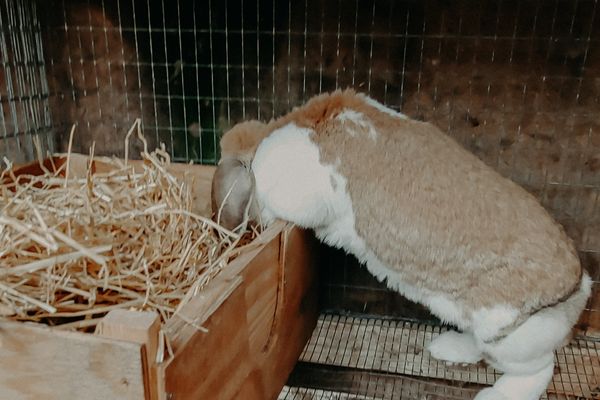
Protein Levels Of The Most Common Vegetables
While not all of these are recommended to feed to your rabbits I want you to see how low the protein is in some of these foods.
Here’s a list of 50 popular vegetables and their approximate protein levels per 100 grams (3.5 Ounces):
- Spinach: 2.9 g
- Broccoli: 2.8 g
- Brussels sprouts: 3.4 g
- Kale: 3.3 g
- Peas: 5.4 g
- Asparagus: 2.4 g
- Artichokes: 3.3 g
- Carrots: 0.9 g
- Celery: 0.8 g
- Corn: 3.2 g
- Cucumber: 0.7 g
- Eggplant: 0.8 g
- Green beans: 1.8 g
- Bell pepper: 0.9 g
- Mushrooms: 3.1 g
- Okra: 2 g
- Onions: 1.1 g
- Potatoes: 2 g
- Sweet potatoes: 1.6 g
- Tomatoes: 0.9 g
- Zucchini: 1.2 g
- Beetroot: 1.6 g
- Cabbage: 1.3 g
- Cauliflower: 1.9 g
- Radishes: 0.7 g
- Squash: 1.2 g
- Turnips: 0.9 g
- Watercress: 2.3 g
- Broccoli rabe: 3.2 g
- Chicory: 1.5 g
- Collard greens: 3 g
- Endive: 1.3 g
- Escarole: 1.2 g
- Fennel: 1.2 g
- Green onions: 1.8 g
- Jicama: 0.7 g
- Kohlrabi: 1.7 g
- Leeks: 1.5 g
- Mustard greens: 2.9 g
- Parsnips: 1.2 g
- Pumpkin: 1 g
- Rutabaga: 1 g
- Snow peas: 2.8 g
- Swiss chard: 1.8 g
- Tatsoi: 2.3 g
- Turnip greens: 2.7 g
- Yam: 1.5 g
- Arugula: 2.6 g
- Radicchio: 1.2 g
- Sprouts (bean, alfalfa, etc.): 4 g

Note: None of these have much protein and levels are approximate and can vary depending on the growing conditions, harvesting methods, and preparation methods. It’s important to remember that vegetables are not typically a major source of protein, but they can contribute to a well-rounded diet that includes a variety of nutrients.
When Can You Give Your Pet Rabbits Treats
I am not saying that you should never give your rabbit anything but alfalfa pellets forever and ever amen. What I am saying is that those things should be given as treats only. And if you are giving your rabbit new foods you should give it in small amounts and be very unpredictable when you do give them treats.
A rabbit’s diet needs to be consistent for them to stay healthy and keep good eating habits. Rabbits can develop a bit of a sweet tooth and only want certain things even if those foods are not good for them. And they can be REALLY stubborn when they only want that one thing. Enough to the point where they will go on strike for several days or even a week if you don’t give them what they want.
Avoid feeding fresh fruit that has high sugar content too often and give them treats in small quantities. Also avoided any fresh greens that have the potential to cause gas.
How To Know If A Baby Rabbit Is Not Getting Fed
Either the kit missed its chance when momma came in the last time to nurse or you have a bunch of food hogs and that one kit started falling behind. There are many different reasons a kit could start falling behind the rest of the litter. But if they do then it’s not going to go well for them.
One or two babies are hogging all the food.
If most of the litter is doing well but there are a few baby rabbits that don’t look like they are growing well. This is probably your issue.
Their bellies will be flat and will have lines across their back.
You likely have a few (or one in particular) of the stronger babies pushing the weaker ones out of the way. Mamma does not have control over who gets there first.
Solution: In this case, you have to help the weaker ones get some food so they can get enough strength to fend for themselves. After about two to three days of helping them feed they should be strong enough to do it on their own.
Example: Here is a perfect example of one baby being a total food hog. She was double the size of the babies until she left. The owner touched base with me after she was over a year old and she is still huge.
Get help and find motivation as we build our intentional backyard farm together.
How To Hand Feed A Baby Rabbit
If a newborn rabbit is not getting fed like it should you will need hand-feed it. There is about a 48-hour window from when it hasn’t gotten enough to when it’s just too far gone. When their skin is supper wrinkly and loose, their belly is flat, and they are really skinny it’s just too late even if they seem to have enough energy. However, there is no harm in trying.
Here is a list of the supplies you would need to had feed a kit if they are not getting enough from their momma.

Supplies To Hand Feed A Baby Rabbit
It is pretty hard to find a good supplement for rabbit milk. I keep a particular kitten milk replacer on hand I LOVE this type of whiskies cat milk. It has a sweet taste and is thicker than other milk replacers I’ve seen.
It can also stay un-refrigerated for quite a while if not opened. The small container makes it great for using a little bit for one litter rather than throwing out a whole carton of goat milk after you’re done. Check this kitten milk out on amazon.
Syringes or eye droppers are the best for hand-feeding kits. You can force the issue a little if they are refusing to eat.
Need More Help With Kits Not Getting Fed?
Here is this full post where you can get more help on how to hand-feed kits and how to know they are doing with feeding.
Other Rabbit Milk Replacers
- I have tried puppy milk replacers and that just didn’t seem to work it was way to watery and didn’t give them any kind of boost like the milk replacer does.
- Cow’s milk might be ok if it was whole. Not from the store. You need thick milk to work well with rabbits. The reason is because kits are only fed once or twice a day and it needs to last longer. Most nursing animals nurse several times a day.
The droppers are AMAZING and are a great help feeding the babies really well.
Hold the baby as shown below. Place the dropper (or syringe) in the side of the baby’s mouth just enough to get it to open. I like to go from the side of the baby’s mouth so you are not damaging the teeth.
It’s also easier to get them to open their mouth that way. They should be more willing to suck with the feeder out in front of them. Just test it out to see what works.
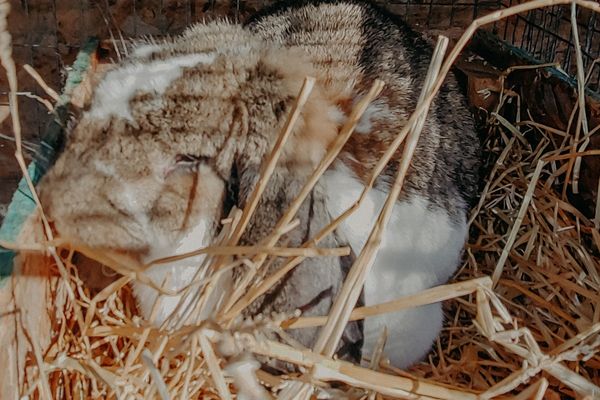
Then drop a bit of the milk in. It might take a little trying to get the baby to feed. Once they realize it is food they tend to be more willing.
Don’t worry about overfeeding. The babies who get fed well from mom have huge bellies so try to get them to eat at least 2ml or 2 flent droppers full.
If they stop wanting to swallow they often are tired and are dozing off. Just come back and do some more later.

